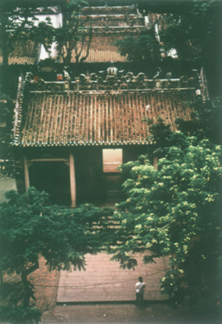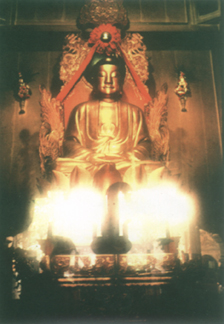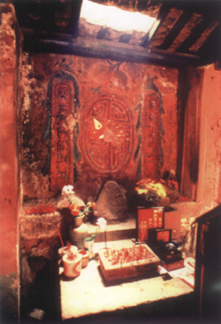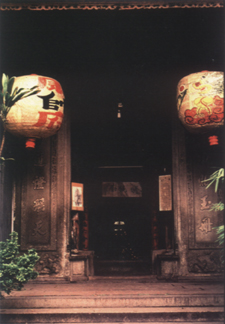§1. POPULAR BELIEFS IN MACAO

Macao used to belong to the Xiangshan· district, which is known as Zhongshan· today. According to records in Lands: Evolution, one of the volumes of Xiangshan Xianzhi· (Chronography of the Xiangshan district) — hereafter named: Shen Zhi's· (Shen's Chronography) — compiled by Shen Lianghan· in the winter of 1673 (Kangxi· reign, year 12), Xiangshan was a former region of Yangzhou· From 214BC (the first Emperor of the Qin· dynasty, year 33) until the end of this dynasty, the territory was called the Nanhai· province. During this period Zhao Weituo· occupied the region and created the Panyu· district that included Xiangshan.
The province of Xinhui· was created during the Jin· dynasty in the AD420 (Gong· reign, year 2). It was divided into the Feng Dong· and Feng Ping· districts and the Gu Zi· and Gong Chang· regions (Macao belonging to the latter) of the Xiangshan district were annexed by the Feng Dong district. This lasted until AD590 (Wendi· reign, year 10) during the Sui· dynasty when Xiangshan was once more part of Nanhai.
In 757 (Suzong· reign, year 2) during the Tang· dynasty, a new administrative division consigned the majority of Xiangshan to the Dongwan· district which covered the various different regions of the South East like Gu Zi and Gong Chang, Xiangshan becoming the district capital.
In 1082 (Shenzong· reign, year 5), during the Song· dynasty, the zhai· was founded in Xiangshan which also belonged to Dongwan. In 1152 (Gaozong reign, year 2), during the Southern Song· dynasty, Xiangshan finally became an independent district directly dependent on Guangdong. ·
Daoism emerged towards the end of the Western Han· dynasty, or rather towards the end of the second century AD, and spread throughout the Panyu district of Guangdong province in the third century. At that time, the South-Eastern area of Xiangshan belonged to the Panyu district. Being a religious belief of popular origin it was not surprising that Daoism was then introduced into Macao. An ancient legend with Daoist influences, the legend of the fairy Chen Renjiao, · which spread throughout the Xiangshan district confirms this. According to Shen's Chronography in volume ten of Waizhi-Xianshi·(The interpretation of the Gods).
"From an early age Chen Reniao was very intelligent. [...] She always dreamt that she amused herself by eating the early morning clouds and drinking the beautiful jade liquid. She never remembered her dreams until the night of the 15th August when several dozen immortals woke her up and invited her to visit the Celestial Goddess Palace. When flying over the valley of Long Tangtan· on her return, Renjiao suggested to the Wuxing· (Five Immortals) who accompanied her that they go and fish at Shenjing. · And this they did. On arriving, Renjiao began to fish and enjoy herself, throwing the fish to the swans or singing to the moon. When some fishermen became aware of her presence the group flew off towards Heaven. But footprints remained as vestiges of their presence. The people then baptised the place as Xiannü Ao (Bay of the Fairy) [...]."
This legend was also registered in volume six of Guangzhou renwu zhuan· (Biographies of Guangdongnese) compiled by Huang Zuo· of the Ming· dynasty between 1506 (Zhengde· reign, year 1) and 1526 (Jianjing· reign, year 5), as well as in the Chronography of the Xiangshan district — hereafter named as Bao Zhi· (Bao's Chronography) — compiled by Bao Yu· in 1750 (Qianlong· reign, year 15) during the Qing dynasty. According to Renwu Liezhuan-Mingchen· (The Lives of Famous People and Ministers) in volume six of Bao's Chronography, the biography of Chen Liu can be found who, according to Bao, lived between the years 196 and 219 [sic]. Chen Lin was a forerunner to Chen Renjiao which infers that the legend could not have appeared before 219. Bao's Chronography also records the story of Renjiao in the Han dynasty and so she probably lived in the kingdom of Wei· during the Three Kingdoms· period (220-265).
Xiannü Ao, known today as Da Hengqin· Island, is to the east of Coloane not far from the Macao peninsula. For this reason we are able to consider this legend as essentially the oldest proof we have of the development of Daoism in the territory and nearby islands of Dangzi·(Taipa) and Luhuan· (Coloane) as well as Da Hengqin and Xiao Hengqin. · If Huang Zuo's records are correct we can presume that the legend had spread throughout the Lingnan· region (the Southern Mountain range) by the sixth century.
According to existing records, during the Song dynasty Daoism was already widely known in the Xiangshan region. A few of these records go as follows:
1. According to Si· (Temples), volume ten of Shen's Chronography "[...] Xu was the daughter of Xu Dongzhai. From a young age she nurtured a rare yearning that her parents could not halt. She studied Daoism while fasting. The monk Zhao Xi built a temple just for her where she was permanently surrounded by tigers to protect her [...]."
This record contains some make-believe, but it is true that during the Song dynasty it was normal for woman to devote their lives to the study of Daoism in isolation in the mountains.
 Guanyin Tang 觀音堂 Kun Yam Tong Temple, Macao.
Photograph taken in 1990 by Amilcar Carvalho.
Guanyin Tang 觀音堂 Kun Yam Tong Temple, Macao.
Photograph taken in 1990 by Amilcar Carvalho.
2. Also according to volume ten of Shen's Chronography: "The abandoned temple of Beiji· is found to the east of the district. [And a footnote adds:] It was built by the lianguang zongdu· (Governor) of the district, Fan Wenlin, · in 1169 (Qiaodao· reign, year 5) during the Song dynasty and was rebuilt by a distinguished official in 1243 (Zhunyou· reign, year 3) during the same dynasty [...]."
The footnote includes an extract written in 1245 about the temple: "[...] the Daoist temple of Beiji is the most imposing of the district. [...] As soon as I took over the position, I visited it and discovered that there was nothing to compare with its sobre, imposing and grand character, throughout Central China." The temple had vast rooms and altars dedicated to San Qing· and Lu Lingguang. Its presence clearly shows that, despite the existence of temples when the Xiangshan district was created, the rapid spread of Daoism in the district undoubtedly influenced Macao. The same note says: "After the temples of Wu Liang and Bao Qing· and the Daoist temple of Beiji were built, the inhabitants, with the authorisation of Fan Wenlin, the Governor of the district, built other similar temples in such great number that they could not be recorded in their entirety." From this it can be supposed that in Xiangshan at that time, there were many Buddhist and Daoist temples as well as small chapels of the same type. The same note says that all these religious buildings were destroyed during the Yuan· and Ming dynasties, mainly in 1523.
3. Also according to volume ten of Shen's Chronography: "The Daoist temples built in the Song dynasty were, amongst others the temple of Zhenwu· — built by Zhao Shicong· of the Song dynasty and destroyed by the war at the end of the Yuan dynasty —; the temples of Jian Fu· —the first being in the village of Haoyong, · built by Chen Jinwu· during the Shaoxing· reign (r.1131-†1162) of the Song dynasty — and the second in the village of Gu Zhen· — built by Huang Yan· during the same reign —; the temple of Xian Zhen· — built by Lin Zhongfang, · during the Shaoxing reign —; the temple of Ji Zhen· — built by Liu Bicong, · during the Shaoxing reign —; and the temple of Zhongyong· — built by Ruan Neng'an· during the Baoyou· reign (r.1253-†1258). Apart from these, the temple of Chenghuang, · the temple of Dongyue· and others, were also built in this period [...]."
According to the entries mentioned above we can see that in the Xianshan region during the Song dynasty the Daoist worship of San Qing (Three Purities), Lu Lingguang, Tianhou· (Goddess Ama), Dongyue Dadi· (The Western Mountain Emperor), Chenghuang (The City Emperor) and Kang Sanshen· already existed. Large houses and temples were built where women could study the doctrine and this was welcomed by all social sectors. We believe that the Daoist belief had definitely been introduced into Macao and the surrounding region by, at least, the reign of Shaoxing of the Southern Song dynasty.
 Guanyin Tang 觀音堂 Kun Yam Tong Temple, Macao.
Photograph taken in 1990 by Amilcar Carvalho.
Guanyin Tang 觀音堂 Kun Yam Tong Temple, Macao.
Photograph taken in 1990 by Amilcar Carvalho.
The following entries in Shen's Chronography tell us about the continuation of the Daoist faith during the Yuan and Ming Dynasties:
1. Once again, according to volume ten of Shen's Chronography during the Yuan dynasty the Kangshuai· temple was built by Du Lihe between 1279 and 1294; and the Hongshenwang· temple by Yuan Yuanlong between 1341 and 1368.
2. According to the same source, the Tianfei· (Celestial Goddess) Palace was built during Hongwu's· reign of the same dynasty with Chen Yu's· money.
3. Accordance to Shen's Chronography volume two, during the reign of Chenghua· (r.1465-†1487) of the same dynasty, the Governor of the Xiangshan district, Zhu Xian, · built altars to the Earth, Rivers and Mountains, Wind, Clouds, Thunder and Rain, and to the City Chenghuang during his office (1478-1485). During Zhengde's reign (r. 1506-†1521) the temple of Tianfei· (Goddess of Heaven) was built by Sheng Shaode· and later abandoned. In 1545 (Jiajing reign, year 24) the Commandant Tian Ni· rebuilt this temple. In 1549 (Jiajing reign, year 28) the temple of Guandi· was built. In 1615 (Wanli reign, year 43) the Governor of the district, Dan Qiwen, · commanded Lu Weizeng· to build the Wengchang· (Cultural Prosperity) Pavilion and between 1614 and 1615 he ordered another temple dedicated to Tianfei to be built. There is further information on the building of the temple of Beidi· (Emperor of the North), by order of the Xiangshan district, in 1465 (Chenghua reign, year 1) of the Ming dynasty. It was restored twice, once 1533 (Jianjing reign, year 12) and once in 1576 (Wanli reign, year 4) and it underwent extension in 1614 (Wanli reign, year 42).
The dates and events mentioned above clearly show the continuation and development of Daoist worship, particularly the worship of Hongshenye, · Tianhou, Wenchang Diyun· and Kanggong, · during the Yuan and Ming dynasties, in the Xiangshan district. It is reasonable believe that these activities inevitably reached Macao, above all those related to Beidi, whose temple was back to back with the [city] wall that separated Gongbei· [Road] from Macao.
 Chinese sidewalk temple, Macao.
Photograph taken in 1990 by Amilcar Carvalho.
Chinese sidewalk temple, Macao.
Photograph taken in 1990 by Amilcar Carvalho.
§2. DAOISM IN MACAO
According to Fojiao dajiao simiao· (Buddhist and Daoist Temples) in volume eight of Bao's Chronography: "[...] The Daoist temple [of Beidi] can be found in the Gongbei Road, outside the Gates of the Northern Enclosure." Then Buddhist and Daoist Temples in volume five of Zhu Zhi· (Zhu's Chronography — yet another chronography relating to the Xiangshan district, this time compiled by Zhuhai· in 1827 (Daoguan· reign, year 7), during the Qing dynasty, supplies further details: "The Daoist temple of Taqing· is situated in the Gongbei Road, outside the Gates of the Northern Enclosure, to the right of the temple of Beidi, and was built by Liang Jinxia· in 1734 and was named Taiqing Ge· (Taiqing Pavilion); it was restored by Gao Yicheng· and Li Dongshu· in 1793 and they added two additional monuments."
The "Gongbei Road" is the site known today by the same name. It is situated outside the Border Gates between Macao and Zhuhai. · From this we can conclude that, from at least 1734, the temples mentioned above, the first one in particular, directly influenced the development of Daoism in Macao from the point of view of geo-religious relations.
According to the present Administrative division the Territory of Macao covers the Peninsula of Macao and the Islands of Taipa and Coloane. The oldest information on the territory referring to Daoism goes back to the years of Chenghua's reign of the Ming dynasty. An old popular legend says it was a merchant born in the Min Chao· region who built the temple of Mazu Ge· (Port.: Templo da Barra) in Macao during Chenghua's reign. The 1987 inscription on the monument refers to the event of the fifth centenary of its construction, Cao Sijian· being responsible. It also says that Macao was a fishing port for the first few years and there were many immigrants from Quanzhou· and Zhangzhou· and the construction of the temple was due to them.
In accordance with details found in the already cited works, the first temple was made up of only a few pavilions and was later enlarged. The oldest part is actually the Hongren Ge· (Hongren Pavilion), built in the first year of the reign of Hongzhi· (1488) of the Ming dynasty. The temple's stone pavilion proves that by 1605 at the latest, the belief in the Goddess was at least widespread in the Macao Peninsula since on the door frame there are four Chinese characters: "Shenshan Diyi"· ("The First Sacred Mountain"), followed by three lines with the following inscription: "Built in the Yisi· year in the Wanli's· reign of the Ming dynasty, by popular demand [...]".In Aomen Jilue· (Monograph of Macao) by Yin Guangren· and Zhang Rulin, · published in 1751 (Qianlong reign, year 16), it is written that the temple was known as "Tianfei Miao"· ("Temple of the Goddess") and the place where it was, was called "Niangma Jiao"· ("Cape of the Goddess"). In actual fact the Peninsula of Macao's oldest name was probably Mazu. ·

Kanggong Miao 康公廟 Hong Kung Miu, Macao.
Photograph taken in 1990 by Amilcar Carvalho.
According to An Historical Sketch of the Portuguese Settlements in China; and of the Roman Catholic Church and Mission in China, [...] by Andrew Ljungstedt, first published in Boston in 1836, the first Portuguese arrived at a small and deserted island in 1557 that was called "Ama".· It is interesting to note that the oldest known name of the territory in a foreign Language was "Amaqua", probably a translation of the pronunciation 'Ama Ao' or 'Ama Gang' (Ama Gate). 'Macau', or 'Macao' being the name used in foreign languages, is probably an abbreviation of the very same name. This is the opinion of the majority of Western historians such as Sven Egerod [sic] and Graciete Nogueira Batalha, and the Chinese historian Zhang Tianze. · Moreover, it could be said that the region of Macao was an area that worshipped Mazu, which was part of the Daoist Faith that dated back some four hundred and forty years.
The Peninsula of Macao had another pavilion dedicated to the Goddess in the temple of Kang Zhenjun· in Wangxia, · built around 1792 which is confirmed by a lapidary inscription from 1882. The temple in Rua dos Pescadores (lit.: Fishermen's Street), built in 1865, has an inscribed tablet dated 1987, and according to which, the oldest temple dedicated to the Goddess was the Majiaoshi· Temple. A pavilion to the Goddess existed on the Island of Taipa which was built between 1662 and 1722. The Island of Coloane also had a temple dedicated to her, built in 1677. According to preliminary figures, from the time of the Ming dynasty the Peninsula of Macao had eight temples dedicated to the Goddess, the oldest of which dates back more than five hundred years.
In the early hours of the morning, on the 8th of February 1988, the pavilion of the Goddess in the Mazu Temple was destroyed by a fire. A large, six foot high, two hundred year old bronze bell melted, yet the wooden statue of the Goddess suffered barely any damage. It is believed that this is due to the intervention of the Goddess herself and since then the temple was visited more frequently. Even now on the last day of every lunar year many Macanese residents and tourists from Japan, Korea Taiwan and other places in Southeast Asia meet at the Mazu Temple. Thus, belief in the Goddess underwent a large development in Macao.
Apart from this Goddess there is the popular belief of Zhu Daxian· (God of the Sea), protector of sailors and fishermen, many of whom worship him in order to free themselves from pirate attacks. This Divine entity has neither a specific altar nor day. His day of worship depends on the outcome of geomancers. Another Divine entity of the Sea is the Goddess Sanpo· whose Sanpo Miao· (Sanpo Temple) was built in 1845 on the Island of Taipa and which is now a ruin. Two engraved stones remain of the original temple, one dates back to 1859 (Xianfeng· reign, year 9) and the other to 1864 (Tongzhi· reign, year 3). There are six other stone incriptions which are older and describe the belief in the Goddess Sanpo and the God Huizhou. · Sanpo intervened in the fight against bandits and pirates, taking care of local stability and security. As for her origin, she is thought to have some connection with Tianhou, since, according to Records of Xu Liansheng, compiled by Yu Yue· during the Qing dynasty, Sanpo is the third sister of the Tianfei and her holy day is the 22nd of March, the day before the Celestial Goddess's holy day, which demonstrates their close relationship.
In Macao, Hongsheng· is worshipped in the Three Saints Pavilion, built in 1833 on Coloane, and in the Hongsheng Pavilion in the temple of Kanggong. Shuishang Xiangu· (Fairy of the Sea) and Yuecheng Longmu· (Wife of the Dragon Yuecheng) are also Seafaring divinities. It is interesting to note that the extremely important Sea God, Hongsheng, never held a place of prominence in Macao and was only worshipped in minor temples.
Macao has historic retreats of 'orthodox' Daoism like, for example, the temple of Lüzu Xianyuan, · not far from the ruins of St. Paul's Church. According to tablet inscriptions belonging to the temple, its structure was built in 1891, the statue of its main divinity being originally in the Chaoyuan· Cave, in the Luo Fu· Mountain. Another example is the Zhang Tianshi· Pavilion in the temple of Yiling. ·
Macao is also the home of the Xinshan· branch of the Chun Yang School — according to the Daoist Taiyi· classification. In 1964, Qu Zhanbie and Luo Liansong· among others, built the temple of Zique· in Estrada de Adolfo Loureiro (Adolfo Loureiro Road), and it was later moved to Avenida do Almirante Costa Cabral (Avenue of the Admiral Costa Cabral) where the altar to the Ancestral Xin Shan can be found. Almost immediately, an altar was erected in Rua da Ribeira do Patane. Later on, Luo Ziyan, · Luo Lianhui· and other leaders of the Xinshan branch of the Chun Yang School moved to Hong Kong with the aim of spreading the system, resulting in its decline in Macao due to the gradual lack of followers.
During the Second World War Japanese invasion, Li Jintang· (the Daoist name for Ruo Xu)· moved his altar from the village of Meihua· in the Guangdong province to a site adjacent to ruins of St. Paul's Church and this became the predecessor of the Chongshuge· Buddhist Society, in Hong Kong.
Other popular beliefs exist in Macao which are chronologically represented by the temples of Kangjun· of Wangxia, built before 1792; Xuan Wu, · built in 1843, in Taipa; Kangjun, built before 1860; Tanxian, · built in 1862, in Coloane; Nühua, · built in 1888; Baogong, · built in 1889; Ne Zha, · built in 1898; and Guandi, in the Peninsula of Macao and the Islands of Taipa and Coloane.
In the temple of Tanxian, built in 1862, on the Island of Coloane, evidence can be found that Tanxian, alias Tangong, · appears as a child. His real name is thought to be Tan Gongdao· and is thought to have come from Huizhou. According to the forty fourth volume of Tan Gondao· The Chronography of Huizhou: "Tan Gondao was a good man who became a hermit, and went on to study Daoism in the Jiulong Shan (Nine Dragons Mountain). On his walks across the mountain he was always accompanied by a tiger which helped him find food, leaving all those who had the opportunity to observe the scene alarmed." In the temple on Coloane there is a picture on the wall of a ferocious tiger.
An inscription in the temple of Tangong in Shaojiwan, · in Hong Kong, states that: "In Guangxi· reign, year 27, during the Qing dynasty, an emigrant who lived in Huang Niyong· built this temple. It is said that the place on which it was built was pointed out by Tangong himself, who appeared here as a child. Tangong was born in Huizhou and from an early age he learned how to predict the future and gained the power to heal [...]. The 8th of April is his holy day, which always brings many visitors."
An engraved stone in the same temple, records: "The God Tangong came from the Nine Dragons Mountain [...]." This Nine Dragons Mountain will almost certainly be the same as the one mentioned in The Chronography of Huizhou.
The most representative organisation of this Faith in the Portuguese territory is The Daoist Association of Macao· is responsible for founding a cemetery on the Island of Taipa, in 1974, where an inscription by Mr. Luo Zhiguang,· Vice-President of The Daoist Association of Hong Kong· can be found. From direct talks with this gentleman we have become aware of the ephemeral existence of the Xian Tian Dao· tendency in Macao which has now disappeared.
In the temple of Yiling, built in 1895, an altar erected in honour of Jigong· and an inscription in wood with his name can be found. Jigong is revered by the followers of the Daoist system Yi Kuan Dao, · which confirms information stemming from Hong Kong of the existence of this Faith in the Portuguese territory.
Although of a secondary nature, other figures of the Daoist Faith present in Macao should be pointed out, such as: Shi Gandang, · God of the Earth; Caibo Xingjun; ·Master Lu Ban, · God Protector of Carpenters; the Guanghua Emperor; Master Huo Tuo, · God Protector of Doctors; She, Fushen, · an Auspicious God, Taisui, · God of the Thousand Years, and Houwang. ·
Translated from a Portuguese version of the Chinese original by: Louisa Hoyer Millar

* Studied Chinese Literature and Language at the University of Macao, Macao. Assistant lecturer of History in the Arts Faculty of that University. Historian and researcher on the History of Luso-Chinese Relations and Religion in Macao. Author of several articles and publications on related topics, amongst which the Chinese Historical Records from Taipa and Coloane, · Daoism in Hong Kong and Macao, ·The Economic History of Macao· and Religion in Macao. ·
start p. 55
end p.